How the Hasina regime became so unpopular
Kallol Mustafa
Sheikh Hasina, Bangladesh’s longest-serving prime minister till date, was forced to resign and flee the country on August 5, 2024, amid a mass uprising. The primary reason for the end of her 15 and a half years of rule was the killing of several hundred people by indiscriminate firing of law enforcement agencies (LEA) on the protesters during the quota reform movement, who evolved into a mass uprising led by the students. According to The United Nations Office of the High Commissioner for Human Rights, around 650 people were killed between July 16 and August 11. Of these, nearly 400 deaths were reported between July 16 and August 4, while around 250 people were reportedly killed following the new wave of protests on August 5-6.
However, behind this primary reason are the deprivation of voting rights and freedom of speech, enforced disappearances, extrajudicial killings, police oppression of opposition activists and dissidents, state-sponsored looting of public and private banks, extensive corruption and money laundering by people close to the government, high inflation, subservient foreign policy towards India, etc during Hasina’s authoritarian regime, which caused deep public discontent.
Although efforts were made to hide the Hasina regime’s bad governance by gagging the media and free speech and using fake statistics of economic growth and various visible infrastructure development projects, her downfall could not be prevented. It is important to learn from the history of the Hasina regime so that such incidents can be prevented in the future. Here are the major reasons why this government became so unpopular with the people of Bangladesh.
15 years of dysfunctional democracy
Electoral authoritarianism
Sheikh Hasina became the prime minister after her party, the Awami League (AL), won the ninth parliamentary election in 2008 under the caretaker government, by a large margin. But then she abolished the caretaker government system and established an electoral system where regular elections were held every five years without real electoral competition. The opposition parties did not or could not participate in these elections, and even if they did participate, there was widespread vote fraud. The opposition parties were not allowed to carry out any political activities freely during the pre-election period either. The election field was made contest-free by arresting thousands of opposition activists in false cases and forcing them to leave their localities.
In 2014, the ruling AL won 153 seats uncontested in the 10th parliamentary election, held unilaterally without the participation of opposition parties, and formed the government. The 2018 election was marred by electoral irregularities, like stamping ballot papers the night before the polls and ballot stuffing by capturing booths on election day. And in 2024, Bangladesh witnessed yet another one-sided election, marked by opposition boycott, low voter turnout, violence, and claims of vote rigging, after which the ruling AL formed a government for the fourth consecutive term with an absolute majority. In this way, even though there have been regular elections in Bangladesh for five years, Sheikh Hasina’s government has not been accountable to the people. As a result of this unaccountable authoritarian rule, the rule of law and human rights in the country deteriorated drastically and people had to suffer greatly due to the economic crisis.
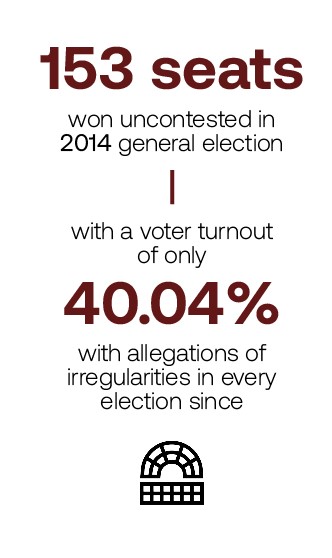
Restriction in freedom of expression
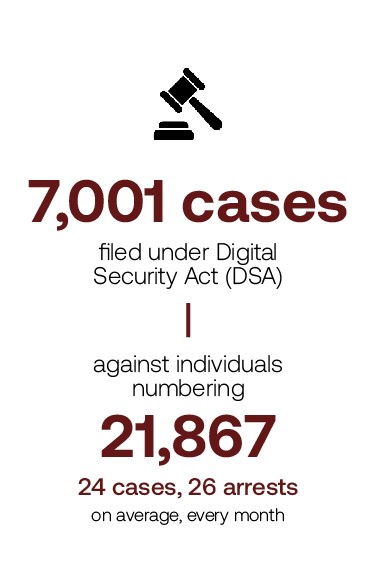
During Hasina’s rule, freedom of expression was severely restricted via different laws, such as the ICT Act, 2006 (amended in 2013), Digital Security Act (DSA), 2018, and Cyber Security Act (CSA), 2023. These acts allowed LEAs to detain and indefinitely imprison anyone without an arrest warrant on the grounds of “defamation,” “spreading false information,” “hurting religious sentiments,” “opposing the spirit of the Liberation War,” etc. Thus, by creating an atmosphere of fear, freedom of expression has been taken away from the people, including journalists and political activists. As many as 7,001 cases were filed under the DSA against 21,867 individuals, including journalists and politicians, between October 2018 and January 2023. According to an analysis of 1,436 cases filed under the DSA between October 2018 and September 2023 by the Centre for Governance Studies (CGS), at least 4,520 people were charged and 1,549 arrests were made in DSA cases in five years. At that time, an average of 24 cases were filed and 26 arrests were made per month. More than 32 percent of the accused were politicians and 29.40 percent were journalists. About 78 percent of the complainants were associated with the ruling Awami League. Most of the journalists who were sued were from outside Dhaka.
As many as 908 cases were filed under this law for posting or commenting on Facebook and 528 cases were filed for hurting religious sentiments. Meanwhile, 190 cases were filed alleging that the accused defamed the then Prime Minister Sheikh Hasina, filed mostly by her supporters. Even children were not spared from DSA charges: 28 children were accused and 22 arrested under this draconian law. Apart from prosecutions and arrests, another way of controlling the flow of news was establishing control over the media through party-affiliated businessmen, editors and journalists, shutting down media companies, and exerting pressure on the media through various state agencies, including military intelligence. Besides, the government used to shut down the internet from time to time and ask support from global technology companies like Facebook, Google, and TikTok to block user accounts and pages and remove content.
Enforced disappearances and extrajudicial killings
The Hasina government was involved in crimes against humanity such as enforced disappearance and extrajudicial killing to suppress opposition party movement and dissent. During the 15-plus years of AL rule, many people were picked up from their homes, offices or streets by LEAs disguised in plain clothes, which was later denied officially. Some of them returned, some were found dead, and many remained missing for a long time. Their relatives made rounds of various LEA offices day after day for their whereabouts, without any result.
According to the Asian Human Rights Commission (AHRC), as many as 623 people were victims of enforced disappearance in Bangladesh between 2009 and 2022. Eighty-four of them were found dead while 383 either returned alive or were shown arrested later. At least 153 people are still missing, and there is no information about three others. An illegal secret detention facility known as Aynaghar (House of Mirrors), run by the Directorate General of Forces Intelligence (DGFI), the country’s military intelligence agency, was used to hide the detainees. The Hasina government used to make cruel fun about the victims of enforced disappearance, saying they had gone into hiding by themselves. But we saw that at least three victims of enforced disappearance returned from Aynaghar.
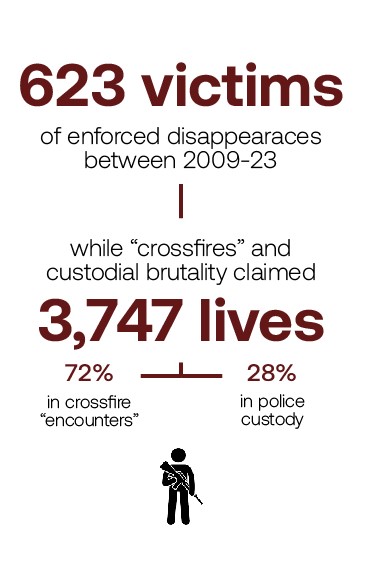
Extrajudicial killings by law enforcement agencies in the name of counterterrorism, counter-militancy, and counter-narcotic operations were a regular occurrence. Every day one opened a newspaper, one would see the news of alleged terrorists, militants or drug dealers killed in the so-called “crossfire,” “gunfight” or “encounter.” The description of these events was almost identical: the victims were killed in a gunfight when the LEA officials were attacked by “miscreants” while going on a weapon or drug recovery operation with the victims. According to human rights organisation Odhikar, as many as 2,699 people were killed in crossfire, gunfights and encounters while 1,048 died in police custody between 2009 and 2023.
15 years without financial accountability
Bank scams
Looting of thousands of crores of taka in the name of loans from banks was a regular occurrence during the Hasina regime. Over the last one and a half decades, scams involving Hallmark, Bismillah Group, Basic Bank, Janata Bank, Bangladesh Bank forex reserve theft, Farmers Bank, Islami Bank, etc have been exposed in various episodes of a mega serial of bank scams. According to a Centre for Policy Dialogue (CPD) estimate, Tk 92,261 crore was embezzled in 24 major banking scams during this regime.
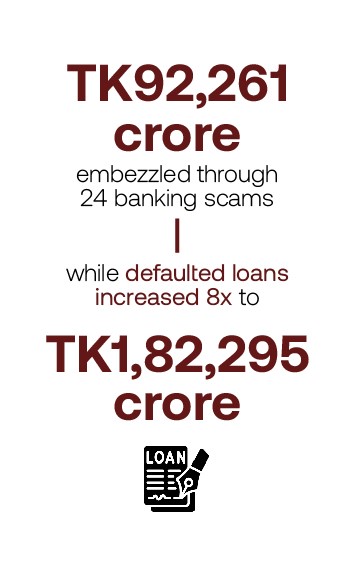
The mechanism through which these scams took place included non-repayment of bank loans by influential business groups; outright fraud; looting a bank as an owner, i.e., acquiring a bank licence using political connections and then embezzling the deposited money under the guise of loans; borrowing heavily from each other’s banks in reciprocal lending practices by private bank owners; bank takeovers of business groups close to the government with the help of state intelligence agencies; and institutional patronage in looting, such as impunity of corruption, non-prosecution of looters, non-recovery of defaulted loans, generous debt restructuring schemes, extension of tenure of bank managers by amending the Bank Company Act, bailout of the scammed banks using taxpayers’ money year after year, etc.
When the AL government came to power in 2009, the amount of defaulted loans in the banking sector was Tk 22,481 crore. After 15 years, this amount increased eightfold, to Tk 1,82,295 crore by March 2024. However, adding to this the overdue loans of Tk 2,57,392 crore which have been repeatedly rescheduled, the actual amount of defaulted loans stands at Tk 4,39,689 crore, which is more than one-third of the total loans in the banking sector.
Stock market manipulation
In the last 15-plus years, at least Tk 1 lakh crore has been looted from ordinary investors of the country’s stock market through manipulation and fraud. The biggest scandal happened in 2011. At that time, due to losses, there were tragic incidents like investors dying by suicide. After this scam, the report of the investigation committee headed by Khondkar Ibrahim Khaled, former deputy governor of Bangladesh Bank, identified 60 individuals behind the stock market fraud, including influential people close to the government, such as like Beximco Group Vice-Chairman Salman F Rahman, who was Sheikh Hasina’s investment adviser. According to the report, the share market manipulation mechanism included artificially increasing the share prices, placement trade, irregularities in the IPO process, suspicious transactions under the cover of omnibus accounts, etc. Although the perpetrators were specifically identified in the investigation report, they were not punished, as a result of which the stock market manipulation continued.
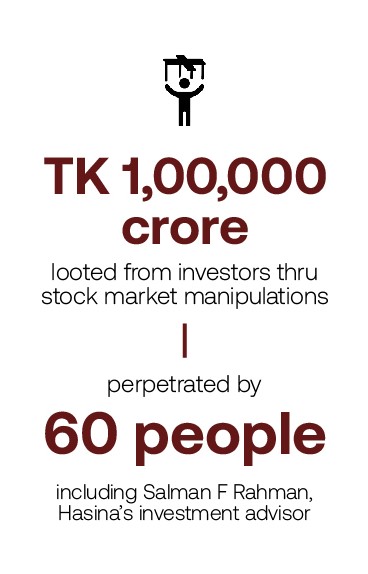
Plunder in the power and energy sector
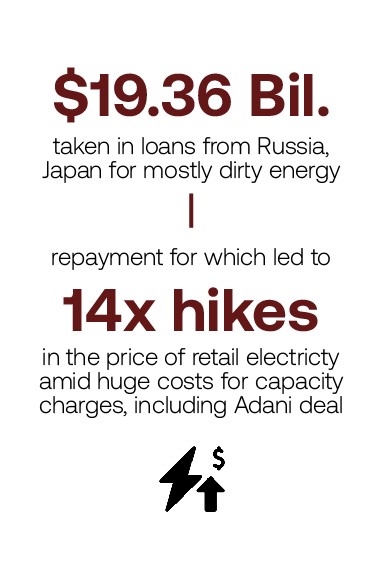
In the name of solving the power and energy crisis, the Hasina government put the country’s economy on the brink of disaster by setting up power plants through local and foreign private ownership and foreign loans and implementing an energy master plan dependent on imports. To protect the interests of various domestic and foreign business groups, the ousted government enacted the Quick Enhancement of Electricity and Energy Supply (Special Provision) Act, 2010, which indemnified the government for its actions in the energy sector from judicial proceedings. As a result, privately owned power plants were constructed one after another with the provision of capacity charge payment, foreign loans were taken by the public and private sectors for power plant construction, and expensive LNG and coal were imported without taking initiatives to extract domestic gas and increase the capacity of renewable energy.
Capacity charges have cost Bangladesh more than Tk 1 lakh crore in 14 years. The government took foreign loans of $11.38 billion from Russia for the Rooppur Nuclear Power Plant, $4.4 billion from Japan for the Matarbari project, $1.98 billion for the coal-based Payra power plant and $1.6 billion for the Rampal coal-fired power plant. The prices of gas, electricity and fuel oil were increased frequently due to the additional cost and huge debt repayment in the power and energy sector, for which the consumers had to suffer. Over the past 15 years, wholesale electricity prices were increased 12 times, while retail prices were hiked 14 times.
Corruption and money laundering
Sheikh Hasina’s autocracy gave birth to a crony capitalist system where government officials, politicians, businessmen and criminals formed a mafia empire. These mafias indulged in usurpation, corruption, looting and money laundering with relative impunity. Reports of corruption against some ministers, published in spite of a lack of media freedom, include that of buying land in advance to make extra money as compensation before acquisition of land for development projects, illegal sand mining, massive corruption in purchases of various ministries, land-grabbing using fake documents, recruitment irregularities, etc. There were reports of gold smuggling, drug trade, human trafficking, and land and house purchase of MPs by smuggling money abroad.
Pro-government businessmen monopolised profits through syndicates, looted banks in the name of loans, and laundered money abroad through hundi and import-export price manipulation. Bureaucrats amassed hundreds of crores of taka through corruption. The ruling party goons and the police extorted money from street hawkers, traders, transport workers, etc. One former police and RAB chief bought and grabbed hundreds of acres of land with the illegal money he earned through corruption and built numerous resorts, houses, etc. One former army chief supported his brothers in passport forgery and was involved in corruption in military purchases. The leaders of the ruling party, government engineers and contractors formed syndicates and awarded half of all contract work of the Roads and Highways Department to just five firms.
A huge amount of foreign currency was laundered abroad, which was earned through corruption, embezzlement of bank loans and manipulation of the import and export prices. This was done by bankers, bureaucrats and politicians close to the government to purchase luxurious properties in different countries such as Canada, US, UK, Malaysia and UAE. We can get an idea about the scale of corruption and the amount of money laundered from the report of Global Financial Integrity (GFI), a US-based research organisation, which says Bangladesh lost approximately $8.27 billion billion annually on an average between 2009 and 2018 because of traders mis-invoicing the values of goods to avoid taxes and/or to move money out of the country.
15 years of poor economic development
Expensive development projects dependent on foreign debt
Between 2009 and 2023, the country’s foreign debt quadrupled from $24.21 billion to over $100 billion. That is, 76 percent of the foreign loans taken since the independence of Bangladesh were taken during the 15-year Hasina regime. But the export earnings and reserves did not increase in proportion to the increase of foreign debt, as the latter was used for costly and wasteful projects that did not generate sufficient forex earnings. Moreover, if the cost of a project implemented by taking loans increases abnormally, the project is no longer economically profitable. The megaprojects using which the AL government boasted development were identified as some of the most expensive in the world. The cost of road construction per kilometre was much higher in Bangladesh than in neighbouring India and China, and even in Europe. The Bus Rapid Transit (BRT) project in Dhaka had also been named as the most expensive in the world. The construction cost of the first metro rail project in Dhaka was also more than double the cost of that built in other countries in recent times. The construction cost of coal, gas and nuclear power plants in Bangladesh was also much higher than the global average.
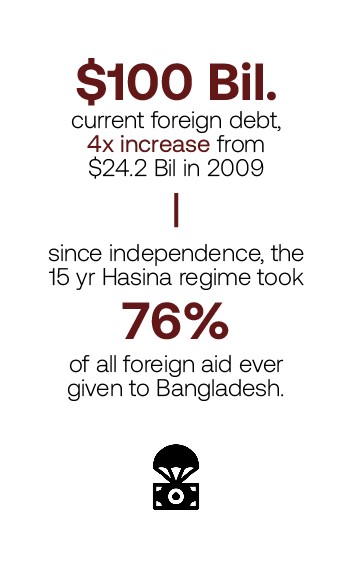
These unusually high construction costs of various megaprojects in the country were the results of irregularities, corruption, and problems with project planning. Construction of these expensive infrastructures with foreign loans might have benefited local and foreign vested interest groups, but the people of the country have to suffer due to the increased debt burden and dwindling forex reserves.
Rise of inequality
During the Hasina regime, inequality increased to an unprecedented level. In the midst of an economic crisis, when the queues for cheaper food items at open market sales (OMSs) and the Trading Corporation Bangladesh’s (TCB) mobile trucks were getting longer, and when low-income people, unable to buy the pricey whole chicken, were forced to buy chicken liver, legs, necks, and broken eggs, the sale of luxury cars and flats increased. While most people in the country were struggling to meet daily expenses—many forced to cut down their food intake—the number of millionaire account holders in the country rose.

According to the Bangladesh Bureau of Statistics’ (BBS) Household Income and Expenditure Survey (HIES) 2022, the wealthiest five percent of the country has 30.04 percent of the country’s total income, while the share of the poorest five percent in the income is only 0.37 percent. According to HIES 2010, the share of the richest and poorest five percent in the country’s income were 24.61 percent and 0.78 percent, respectively. That’s why the Gini coefficient related to income rose to 0.499 in 2022, up from 0.482 in 2016 and 0.458 in 2010, indicating a widening income inequality. The fact that the country’s wealth has accumulated in the hands of a few wealthy individuals is evident from the data provided by the Credit Suisse Research Institute: 21 individuals have wealth of more than $500 million or Tk 5,000 crore in the country. Though the Hasina regime tried to portray this rise in inequality as a “normal” process of economic development, the increase in inequality was not natural or inevitable. It happened because of a particular type of development model and political structure, characterised by regressive taxation, extremely low wages, and rampant corruption.
Culture of impunity
There was an “appalling and pervasive culture of impunity ” in Bangladesh during Sheikh Hasina’s rule, according to UN experts. In cases where there was a political advantage for the ruling party, the trial was completed quickly, but in the cases where the ruling party or those close to the party were the perpetrators, the investigation and trial were delayed for years. Although many individuals were quickly sentenced just for “defaming” powerful politicians of the ruling party including Hasina, there was no precedent of factory owners being punished in any of the incidents where workers died due to owners’ negligence in ensuring their safety, not even after the Rana Plaza collapse or Tazreen factory fire, the devastation of which reverberated globally. Before the 2024 election, testimonies were taken even at night to speed up the trial of opposition party activists in various false cases. Meanwhile, many big swindles like stealing Bangladesh Bank’s reserves or looting banks in the name of loans were not prosecuted. The murders of journalist couple Sagar-Runi, Cumilla college student Sohagi Jahan Tanu and Narayanganj teenager Tanveer Muhammad Taqi were not prosecuted.
Jobless growth and high unemployment rate
During the Hasina regime, high economic growth was fuelled by debt-dependent costly infrastructure projects, which failed to create sufficient and quality employment for the youth in the country. According to the Quarterly Labour Force Survey (LFS) 2024 (January-March) of the BBS, the unemployment rate is just 3.51 percent, with 25.90 lakh unemployed people, but in reality, the number of unemployed is much more. Because in determining this rate of unemployment, the definition of unemployment is considered as people who have not had the opportunity to work for one hour a week. Considering wages in Bangladesh, only one hour of work a week is not enough for livelihood. An idea of the extent of unemployment in the country can be obtained from the BBS Sample Vital Statistics Survey. According to the 2023 data , 39.88 percent of the country’s 15-24-year-old youth or 1.28 crore are not engaged in any study or work, which paints a grim picture of youth unemployment in the country. Unemployment is higher among the highly educated. According to the LFS 2022 , the unemployment rate among those with no formal education is one percent, while the unemployment rate among those with university or equivalent degrees is 12 percent.
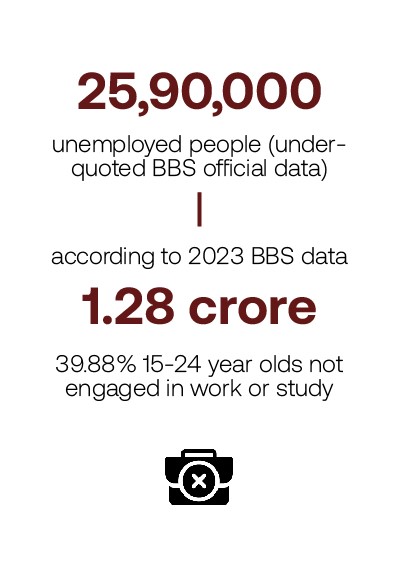
Even when the less educated get a job, they get it mainly in the informal sector and with very low wages. That’s why desperate migration is rising among Bangladeshi youth who are taking deadly risks while crossing the sea by boat. According to a report by the International Organization of Migration (IOM), the number of Bangladeshi migrants going to Italy by boat using the dangerous route of the Mediterranean Sea through Libya is increasing day by day. In 2022, as many as 15,228 migrants from Bangladesh arrived in Italy via the Central Mediterranean Route (CMR) with a majority transiting through Libya. Migrants from Bangladesh constituted a little over 14 percent of all arrivals in Italy—the third most represented nationality. This number was 602 in 2019 (five percent), 4,141 in 2020 (12 percent) and 7,838 in 2021 (12 percent).
Extreme labour exploitation
Bangladesh’s economy has grown in such a way that most of the country’s working people are employed in the informal sector. According to the LFS 2022, 84.9 percent of employed people are working in the informal sector, where there is no guarantee of labour rights, including minimum wage, fixed working hours, paid leave, health insurance, right to unionise, etc. Even in the formal sector, wages paid by the factory owners are not sufficient for a decent living. No minimum wage is fixed in many formal sectors of the country. The 42 sectors where the minimum wages are fixed are also very low compared to the cost of living. The minimum wage of Tk 12,500 in the garment sector, the country’s largest export sector, fixed in 2023, is half of what the workers demanded and not enough to live above the poverty line with families.
Workers’ deaths due to unsafe working conditions is too common a phenomenon. There is no institutional arrangement to ensure the safety of workers in many sectors such as transport, construction, agriculture, day labour, steel, ship-breaking, stone-breaking, etc. According to a report by Bangladesh Occupational Safety, Health, and Environment (OSHE) Foundation, at least 9,263 people have been killed in the workplace between 2013 and 2023. Apart from accidents at work, many workers die every year and suffer from ill health chronically due to an unhealthy working environment in brick kilns, sawmills, steel factories, ship-breaking yards, chemical and plastic factories, leather sector, stone quarries, etc.
15 years of decisions against public interests
Business syndicate and commodity price hikes
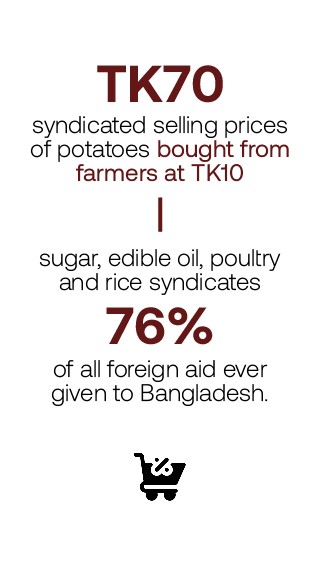
The Sheikh Hasina government completely failed to control the prices of daily commodities. Although the government, in recent times, blamed the Russia-Ukraine war for price inflation, it was observed that even after the cooling down of the global commodity market, prices of daily necessities in Bangladesh did not drop but rose instead, which indicates that local factors such as incorrect government policies and failure in market management were behind this inflation. This abnormal price hike was caused by certain structural factors in the commodity market, namely i) the dominance of a few large business groups over the market; ii) lack of accurate statistics on the demand and production of essential commodities and the illusion of food self-sufficiency; and ii) inadequacy of government action to control the prices of essential commodities.
Five companies dominate the sugar market, four companies control the edible oil market, and four companies rule the poultry sector. Meanwhile, owners of large rice mills are dominating the rice market. Only under such levels of monopoly was it possible to sell broiler chicken at Tk 80-90 more than the cost of production, while egg prices were manipulated through SMS and potatoes purchased from farmers at Tk 10 were put in cold storage and then sold at Tk 70. This is why, although the prices of soybean oil, palm oil, sugar, flour, wheat, onion, lentils, chickpeas and peas decreased in the global market significantly, there was no price reduction in Bangladesh’s markets. While ministers acknowledged the existence of these syndicates on different occasions, no effective steps were taken to dismantle them.
Falsified statistics
Many statistics like GDP growth, population, per capita income, agricultural production and consumption, export earnings, forex reserves, etc were falsified on various occasions during the Hasina regime. For example, the credibility of the GDP growth calculation shown every year was questioned by many economists and local and international organisations. Exports and remittance growth did not correlate with GDP growth; private investment did not correlate with the growth in the industrial sector. During the Covid pandemic, the blatant manipulation of GDP data was exposed. Even though the transport sector, hotel-restaurants and small industries suffered a lot due to the pandemic, the BBS data showed significant growth in these sectors. For example, the BBS showed a value addition of about Tk 24,000 crore or more than 10 percent during the period of July 2020 to June 2021, despite various restrictions on public transport throughout the year. After reviewing the data of the first nine months of FY2020-21, the BBS gave a provisional estimate of 5.43 percent GDP growth. In the next three months, due to Covid, the economic activity was sluggish, but the final data showed a GDP growth rate of 6.94 percent, which raised questions regarding its credibility. About the calculation of GDP, a former secretary of the statistics department said, “GDP growth rate is decided first. Later, the accounts are reconciled through ‘back calculation.’”
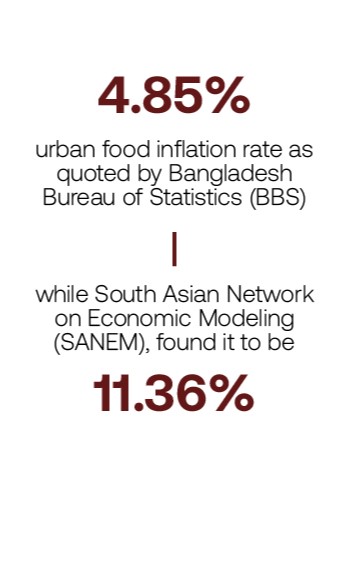
BBS inflation statistics did not match the reality either. Even when the prices of all things were high in the international market and the common people were suffering from the increased prices of everything in the domestic market, BBS showed a decrease in inflation. According to the BBS, in January 2022, food inflation rates for urban and rural areas were 4.85 percent and 5.94 percent, respectively. However, according to the South Asian Network on Economic Modeling (SANEM), in January 2022, the rate for urban and rural areas was 11.36 percent and 11.21 percent, respectively, which is more than double the rates claimed by the BBS.
Even the export earning statistics of different government departments were different. Big discrepancy between the Bangladesh Bank and Export Promotion Bureau (EPB) data was reported several times in the media but was not corrected. At one point, when the International Monetary Fund (IMF) raised questions on the matter, the government admitted that the EPB showed about $14 billion more than the actual exports in the first 10 months of FY2023-24. And in the previous 10 fiscal years, $65 billion additional export was shown.
Damages to forests, rivers, environment

A notable feature of the Hasina regime’s development model was that it emphasised economic growth at the expense of environment and livelihood. For the benefit of the local and foreign business interests, forests and rivers were freely encroached, water and air were polluted, trees and hills were cut down, wetlands were filled. Rivers around the country, including in the capital Dhaka, became polluted due to rampant discharge of industrial waste in them. The present and future of millions of people were harmed because of the pollution of our rivers and canals for the profit of only a few hundred factory owners. Sand was extracted illegally and indiscriminately from the rivers with the backing of ruling party politicians, causing massive erosion of riverbanks and destruction of rural settlements and farmlands. According to a study conducted by the River and Delta Research Centre (RDRC), at least 265 people illegally extracted sand from 132 unauthorised sites in 77 rivers. And out of the 265 individuals, at least 54 were local public representatives and 193 were politically influential.
Dhaka, the capital of Bangladesh, was on the list of the most polluted capitals in the world for several years due to air pollution caused by the fumes of unfit and outdated vehicles, smoke emitted from factories and brick kilns, and dust caused by infrastructure construction and repair. According to the Air Quality Life Index 2023, a global report on air pollution published by the University of Chicago, Bangladesh has become the most polluted country in the world. The average life expectancy of Bangladeshis is decreasing by about 6.8 years due to breathing in this polluted air. Instead of taking an effective role in controlling air pollution, the government itself built coal-based thermal power plants that pollute air and water, as well as legislated to relax pollution standards. For example, in Bangladesh Air Pollution (Control) Rules, 2022, the maximum level of air pollutants emitted by coal-fired power plants was set several times higher than that of coal-fired power plants in China or Japan.
This way, the common people have to suffer due to the previous government’s negligence in controlling air pollution for the benefit of domestic and foreign investors. As the PM2.5 concentration in our air far exceeds the WHO-recommended level, a large number of people are suffering from these diseases, resulting in an average of 78,000-88,000 people dying prematurely every year. Government institutions did not play their role in protecting the country’s environment and biodiversity; on the contrary, they themselves were engaged in environmental destruction. They turned protected forests into tourist centres, built various types of infrastructure destructive to the environment in the name of development, felled trees, cut hills, built buildings by filling reservoirs, built coal-based power plants, and polluted rivers.
Subservient foreign policy towards India
In return for India’s support to stay in power through rigged elections, the Hasina government unilaterally granted various facilities to the neighbouring country, including road, water and rail transit through Bangladesh, access to both the Chattogram and Mongla ports for transit and cargo shipping, access of Indian companies in Bangladesh’s power and energy sector, allowing Indian state-owned corporations to build a coal-based power plant endangering the Sundarbans and to explore gas in the offshore blocks, allowing Indian private corporations like Adani and Reliance to build power plants in Bangladesh, develop a special economic zone, and sales of military hardware.
Meanwhile, India did not give Bangladesh its fair share of water in transboundary rivers, did not sign the Teesta water-sharing agreement, imposed anti-dumping duty on jute exports, fenced the border with barbed wire, and killed Bangladeshi citizens indiscriminately at the border. According to Ain o Shalish Kendra (ASK), 594 Bangladeshis were killed in firing or torture by India’s Border Security Force (BSF) from 2009 to 2023. The Hasina regime did not bother to protest the killings of Bangladeshi citizens by the BSF, let alone put effective pressure on India to stop these border killings. Sheikh Hasina herself admitted that during her tenure, Bangladesh unilaterally gave many benefits to India. In May 2018, after her visit to India, she said at a press conference, “What I have given to India, they will remember it forever.” When she was asked whether she wanted anything in return, she replied, “I do not want anything in return. What is there to want?” Sheikh Hasina was steadfast in her policy of giving unilateral favours to India and not seeking reciprocation throughout her tenure, which also angered the people of Bangladesh.
Due to these reasons, people’s anger against the Hasina regime accumulated over the years like a huge pile of explosives. Indiscriminate killings of the young protesters by the regime in a bid to suppress the quota reform movement acted as a spark on the explosives, which ultimately led to the downfall of the regime.
Kallol Mustafa is an engineer and writer who focuses on power, energy, environment, and development economics. He can be reached at kallol_mustafa@yahoo.com.
Back to Homepage